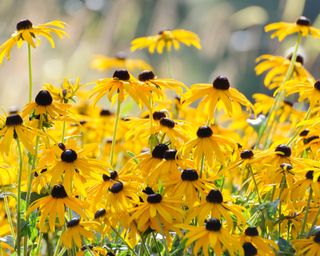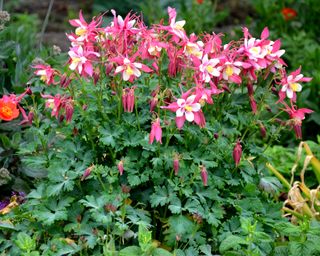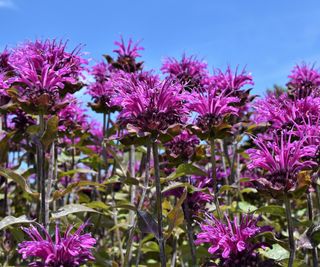North American native flowers come in every size, shape and hue imaginable, and have significant benefits over cultivated blooms. Where to begin with native plant landscaping? There are over 18,000 native plants in North America, many of which are termed wildflowers. The following compiles a list of our favorite top ten varieties to include in your native plant garden.
Why Should You Plant Native Flowers?
Native plants have a number of benefits over hybrids and other cultivated plants. For one thing they are much lower maintenance and tend to require less water, fertilizer and disease and pest control. They tend to be more resilient, vigorous, and drought tolerant with extremely deep root systems. Over thousands of years they have acclimated to local conditions, evolving in order to survive. Being low maintenance also means native specimens are budget friendly but more importantly they are pollinator friendly. Since they are local, native flowers cater to the needs of local pollinators such as bees, birds, butterflies and bats. They also provide valuable wildlife habitat for these pollinators as well as other native wildlife.
10 Native Flowers That Wow
Additional popular wildflowers include anemone, blanket flower, butterfly weed, blue wood aster, desert four-o’clock, foxglove, goldenrod, Mexican hat, prairie verbena, rose mallow, spiderwort, Texas paintbrush, thistle, winecup and so many more.
A Word of Warning About Native Flowers
From state to state, wildflowers may vary or even overlap, but there are literally thousands of varieties. Some are more suited to native plant design within the landscape than others. They may need conditions not found in your yard, or could be highly invasive or the wrong height for your use. Also, while native plants can often be found at the local nursery or in seed packets, not all native flora can be found except in its native habitat. Please do not go and dig up native plants. They are there for a reason and fill a critical niche in a complex ecosystem.



title: “10 Knockout Native Flowers With Brightly Colored Blooms” ShowToc: true date: “2024-10-21” author: “Sherry Webb”
North American native flowers come in every size, shape and hue imaginable, and have significant benefits over cultivated blooms. Where to begin with native plant landscaping? There are over 18,000 native plants in North America, many of which are termed wildflowers. The following compiles a list of our favorite top ten varieties to include in your native plant garden.
Why Should You Plant Native Flowers?
Native plants have a number of benefits over hybrids and other cultivated plants. For one thing they are much lower maintenance and tend to require less water, fertilizer and disease and pest control. They tend to be more resilient, vigorous, and drought tolerant with extremely deep root systems. Over thousands of years they have acclimated to local conditions, evolving in order to survive. Being low maintenance also means native specimens are budget friendly but more importantly they are pollinator friendly. Since they are local, native flowers cater to the needs of local pollinators such as bees, birds, butterflies and bats. They also provide valuable wildlife habitat for these pollinators as well as other native wildlife.
10 Native Flowers That Wow
Additional popular wildflowers include anemone, blanket flower, butterfly weed, blue wood aster, desert four-o’clock, foxglove, goldenrod, Mexican hat, prairie verbena, rose mallow, spiderwort, Texas paintbrush, thistle, winecup and so many more.
A Word of Warning About Native Flowers
From state to state, wildflowers may vary or even overlap, but there are literally thousands of varieties. Some are more suited to native plant design within the landscape than others. They may need conditions not found in your yard, or could be highly invasive or the wrong height for your use. Also, while native plants can often be found at the local nursery or in seed packets, not all native flora can be found except in its native habitat. Please do not go and dig up native plants. They are there for a reason and fill a critical niche in a complex ecosystem.



title: “10 Knockout Native Flowers With Brightly Colored Blooms” ShowToc: true date: “2024-09-28” author: “Eric Wheeler”
North American native flowers come in every size, shape and hue imaginable, and have significant benefits over cultivated blooms. Where to begin with native plant landscaping? There are over 18,000 native plants in North America, many of which are termed wildflowers. The following compiles a list of our favorite top ten varieties to include in your native plant garden.
Why Should You Plant Native Flowers?
Native plants have a number of benefits over hybrids and other cultivated plants. For one thing they are much lower maintenance and tend to require less water, fertilizer and disease and pest control. They tend to be more resilient, vigorous, and drought tolerant with extremely deep root systems. Over thousands of years they have acclimated to local conditions, evolving in order to survive. Being low maintenance also means native specimens are budget friendly but more importantly they are pollinator friendly. Since they are local, native flowers cater to the needs of local pollinators such as bees, birds, butterflies and bats. They also provide valuable wildlife habitat for these pollinators as well as other native wildlife.
10 Native Flowers That Wow
Additional popular wildflowers include anemone, blanket flower, butterfly weed, blue wood aster, desert four-o’clock, foxglove, goldenrod, Mexican hat, prairie verbena, rose mallow, spiderwort, Texas paintbrush, thistle, winecup and so many more.
A Word of Warning About Native Flowers
From state to state, wildflowers may vary or even overlap, but there are literally thousands of varieties. Some are more suited to native plant design within the landscape than others. They may need conditions not found in your yard, or could be highly invasive or the wrong height for your use. Also, while native plants can often be found at the local nursery or in seed packets, not all native flora can be found except in its native habitat. Please do not go and dig up native plants. They are there for a reason and fill a critical niche in a complex ecosystem.


